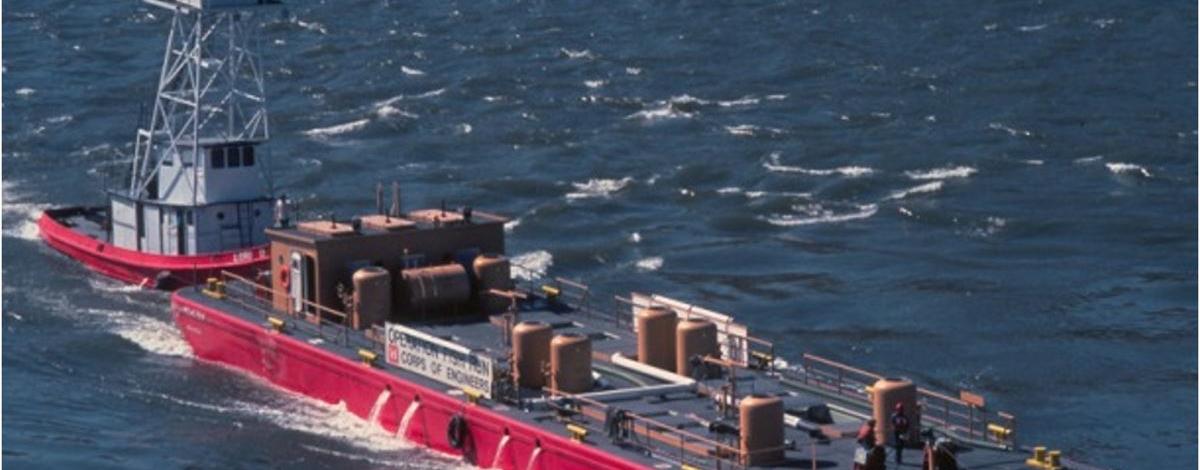Row, Row, Row Your Smolt Gently Down the Stream:
Barging Juvenile Salmon and Steelhead through the Columbia and Snake Rivers
By Allison Lebeda, Joe DuPont, Lance Hebdon, and Jonathan Ebel
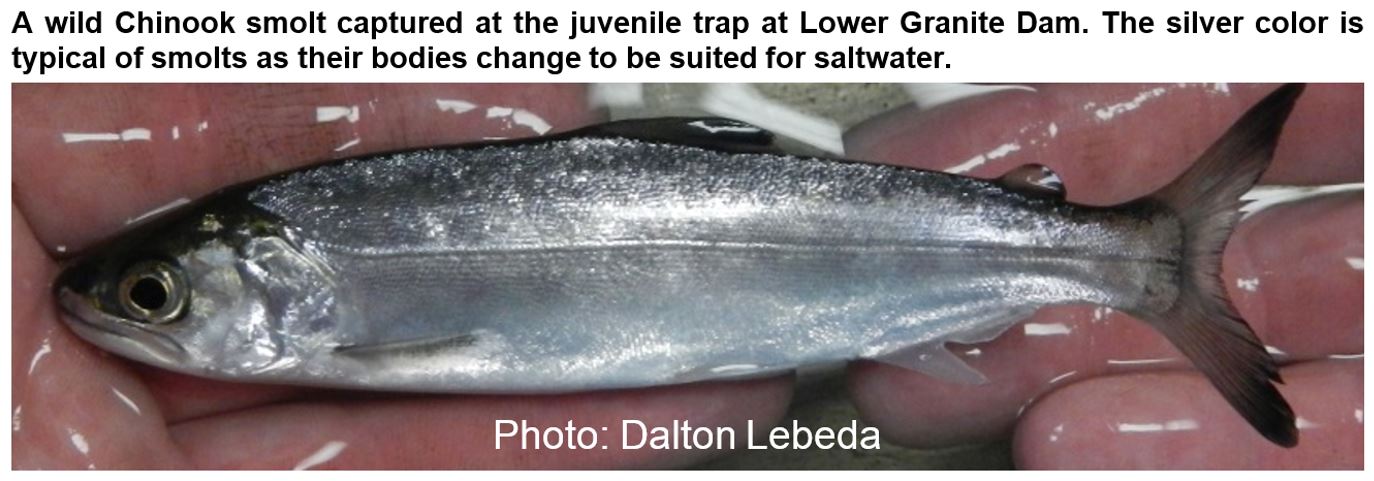
Juvenile salmon and steelhead born in Idaho waters must swim hundreds of miles and navigate a network of eight dams before they can reach the Pacific Ocean. Migrating through the mainstem hydrosystem can be one of the more daunting obstacles these young fish must face. These fish, which we commonly refer to as “smolts” can pass through a dam in one of three ways. First, they can be swept through the turbines, where the water forces large blades to rotate at high speeds. Second, a series of screens can guide smolts away from the turbines where they will be routed through channels and pipes around the dam. We call this the juvenile bypass system. Third, they can be carried over one of the dam’s spillways where they will plunge over a hundred feet into turbulent waters below. Thanks to recent changes in the operations of the dams, most smolts pass over the spillway. The diagram below depicts the three passage routes that smolts can use to pass dams on the Columbia and Snake rivers.
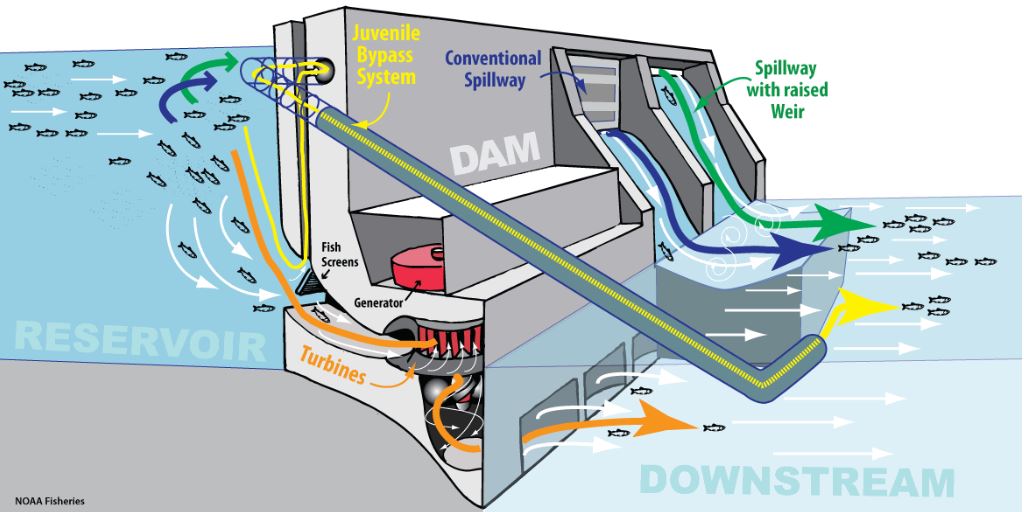
In the late 1970s, poor adult returns of salmon and steelhead prompted the U.S. Army Corps of Engineers (from hereafter referred to as “the Corps”) to develop a fourth method of passing large numbers of juvenile fish past the Snake and Columbia River dams: barging. Initially, two barges were available to transport juvenile fish, but gradually more barges were added, and by 1981, the barging program had the ability to barge large numbers of fish on a daily basis. Today, between 15 and 22 million smolts are collected from the juvenile bypass systems at Lower Granite, Little Goose, and Lower Monumental dams and placed in one of eight available barges. Barging typically occurs from late April through July, and transports smolts through the hydropower system until they are eventually released below Bonneville Dam (see map below). Collection and transportation, known as the Juvenile Transport Program, is a considerable collaborative effort by the Corps with private, federal, and state agencies. Each barging trip lasts two days and covers nearly 300 river miles, but is ultimately faster than the migration for fish that must pass through the dams on their own power.
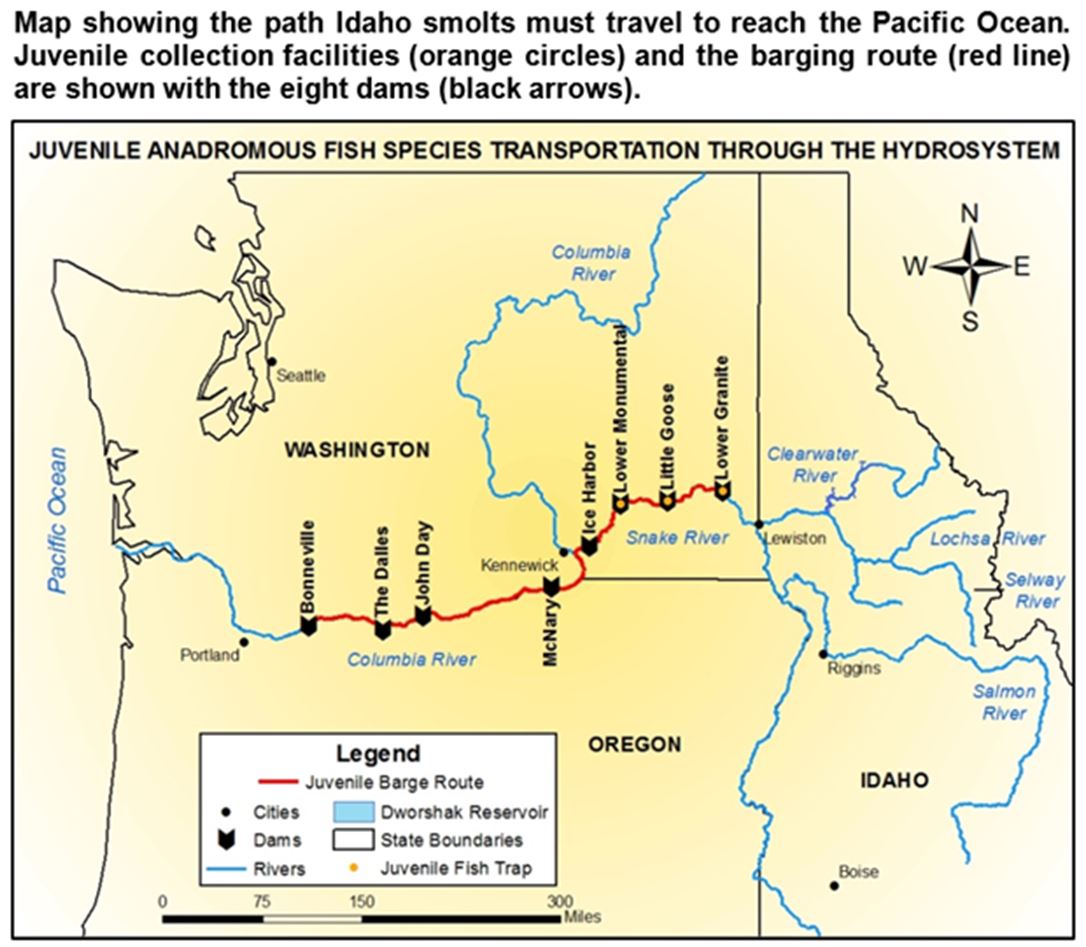
At first glance, barging juvenile salmon and steelhead through the hydropower system seems the obvious solution to increase adult returns. Immediate survival of barged juveniles is nearly 98% compared to the 40-60% survival rate often experienced by smolts that must make the full journey past the dams in-river. Barging was the dominant method of passing smolts through the hydrosystem from 1981 through 2006 when 60-100% of smolts passing the dams were put on barges. However, with increased spill over the dams, the addition of surface spillway weirs, and upgrades to existing juvenile bypass systems, the relative benefits of barging have declined in recent years. The proportion of smolts put on barges now ranges from 10-50% of the run as a result of increased spill over the dams and the consequent decrease in fish entering the juvenile bypass systems.
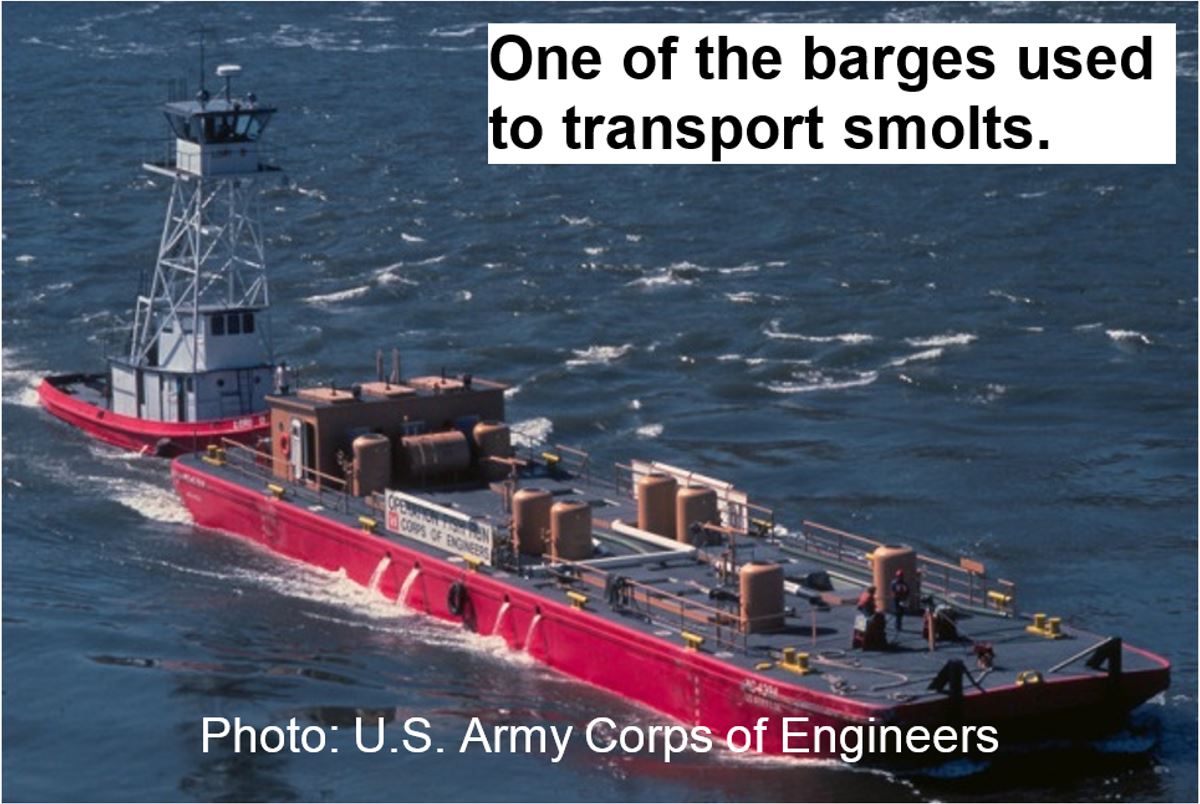
Despite high survival of barged smolts to the release site downstream of Bonneville Dam, transported fish often return at lower rates as adults than fish that migrated down the Snake and Columbia rivers on their own. One explanation for this is multiple species of smolts are often confined in crowded conditions when being barged, which can increase stress and allow diseases to spread more easily between fish. Additionally, returning adults that were barged as smolts tend to migrate upstream slower, fall back over the dams more often, and stray more than fish that were not barged. It is thought that fish may miss critical migration cues in the barges that they would otherwise pick up during in-river migrations.
Ongoing research using smolts tagged upstream of the hydrosystem and tagged at Lower Granite Dam has helped modify the barging program to improve survival of barged fish. Of fish that enter a juvenile bypass system, those that are subsequently transported tend to return as adults at higher rates than fish that are bypassed and returned to the river. This is important because millions of smolts migrate past these dams this way each year. But, it is not as simple as one may think. The relative benefits barging provides to smolts varies by the timing of their migration, what species they are, their size, and whether they are a hatchery or wild fish.
For example, endangered Snake River Sockeye Salmon do not benefit from barging in most situations. This may be because they are smaller, can be easily descaled through abrasion, and prefer uncrowded open-water habitats found in lakes. Meanwhile, steelhead benefit from barging in many situations potentially because they are larger, more resilient, and prefer faster flowing habitats not found in reservoirs. Both these species migrate at the same time and are transported together. Unfortunately, there is no current way to separate the two species after they have entered the juvenile bypass systems and transport-destined raceways.
For smolts migrating later in the season, those that are barged tend to do better than those that aren’t. This is likely because later in the year, migration conditions tend to worsen for smolts as flows decrease and water clarity and temperature increase. These conditions increase their stress levels and increase predation on them.
When you consider all these things, it certainly adds complexity on evaluating whether a smolt should be barged or not. For now, managers have taken a spread-the-risk approach using barging in concert with improving in-river migration conditions. The table below gives a very generalized and simplified conceptual summary of the effectiveness that barging provides to smolts pertaining to a range of river conditions.
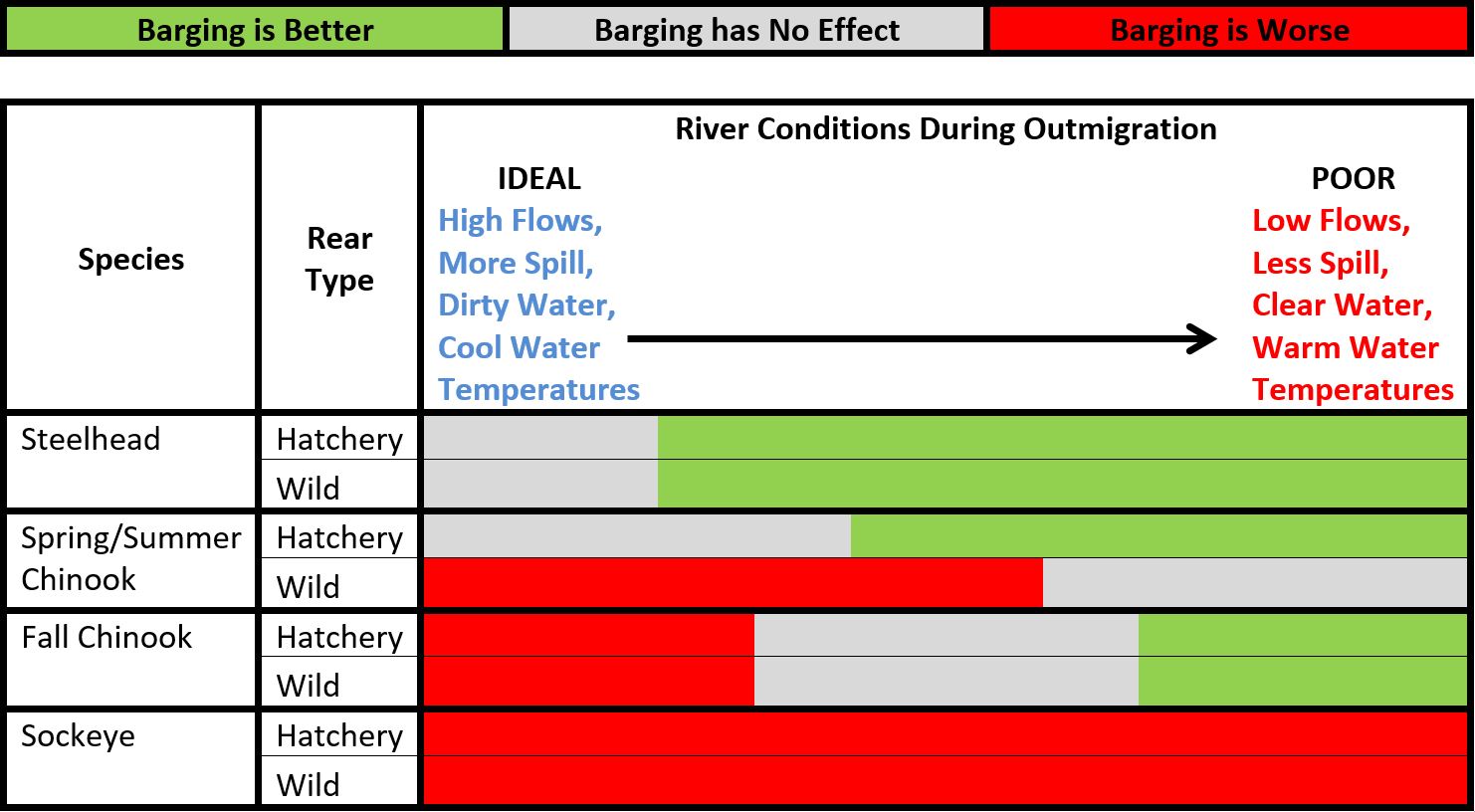
In summary, although barging can increase the number of smolts that reach the ocean, transported fish often return at lower rates as adults than fish that migrate in-river. Under certain conditions, barging juvenile salmon and steelhead can lead to higher survival and higher return rates as adults. Migration timing, fish size, river conditions, and fish species are just some of the variables that play a role in whether barging can be beneficial or not. Researchers with the multitude of cooperating agencies continue to learn from and modify the Juvenile Transport Program to best increase adult returns. Barging juveniles through the complex network of dams is not the sole solution to salmon and steelhead restoration, but it is one of multiple tools managers have that can aid in increasing juvenile survival and adult returns in some situations.

